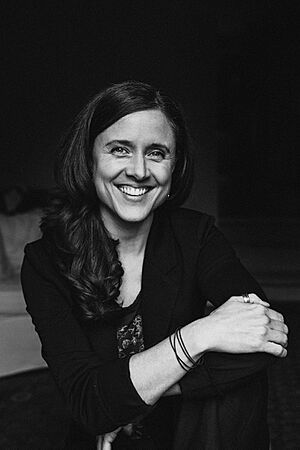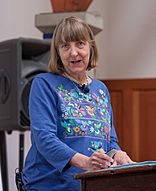Jo-Anne McArthur facts for kids
Jo-Anne McArthur (born December 23, 1976) is a Canadian photojournalist, animal rights activist, and author. She is famous for her photography project called We Animals, which shows how humans interact with animals all over the world.
McArthur uses her photos to teach people about animals. Through her We Animals Humane Education program, she gives presentations at schools and other places. She also created the We Animals Archive, a collection of photos and videos that people can use to help animals. This later became We Animals Media, a media agency that tells stories about the relationship between humans and animals.
McArthur was the main person featured in the 2013 documentary movie The Ghosts in Our Machine. She also started the Unbound Project with Keri Cronin to celebrate women who work to protect animals. She has written several books, including We Animals (2013), Captive (2017), and Hidden: Animals in the Anthropocene (2020). McArthur has won many awards for her powerful photography.
Contents
A Passion for Photography
Jo-Anne McArthur grew up in Ottawa, Ontario, Canada. She studied Geography and English at the University of Ottawa. She discovered her love for photography after taking a class on black-and-white photos. This class sparked her interest and set her on a new career path.
A Camera for Change
At first, McArthur took photos just for art. But soon, she realized her camera could be a powerful tool to make a difference in the world. She wanted to use her photos to create change for animals.
Her early work was similar to street photography, but she began to focus more on animals living in captivity. Sometimes, she had to go undercover to take these pictures. Her work could be very emotional and difficult. Because of the stress from her work, she was diagnosed with post-traumatic stress disorder in 2010, but she has since recovered and continued her mission.
Her photos have appeared in famous publications like The Guardian newspaper and National Geographic magazine. Over 100 animal protection groups have used her images to help their causes.
Winning Famous Awards
McArthur has received many awards for her work. In 2018, she won the Wildlife Photographer of the Year People's Choice award. Her winning photo showed a rescued lowland gorilla named Pikin being held by her caretaker. The picture was taken as they moved Pikin to a new sanctuary in Cameroon. McArthur said she hoped the photo would "inspire us all to care a little bit more about animals."
In 2020, her photo "Hope in a Burned Forest" won another Wildlife Photographer of the Year award. It showed a mother eastern grey kangaroo and her baby in a forest that had been burned during the Australian bushfires. This touching photo also won other major photography prizes.
The We Animals Project
McArthur started the We Animals project around 1998. The idea came to her after she saw a monkey chained to a windowsill in Ecuador. She took a photo because she was upset by how the monkey was being treated. She knew she had an important point of view to share.
The goal of We Animals is to show how humans and animals live together. The project's website says it wants to "break down the barriers" that let people treat animals like objects instead of living beings with feelings.
In 2013, McArthur published a book called We Animals. It features over 100 of her photos along with her writing. The book was praised for being both beautiful and thought-provoking.
We Animals Media
In 2019, McArthur launched We Animals Media (WAM). It is a media agency that shares stories about how animals are treated around the world. WAM has a huge online library of photos and videos. Anyone working to help animals can use these images for free. McArthur hopes that one day, the archive will no longer be needed because animals will be treated with kindness everywhere.
Books About Animals
Captive
In 2017, McArthur released her second book, Captive. This book focuses on animals living in zoos and aquariums. It includes powerful photos and short essays by McArthur. The book encourages readers to think about the lives of animals in captivity.
Hidden: Animals in the Anthropocene
McArthur's third book, Hidden, came out in 2020. She worked with journalist Keith Wilson to create it. The book features photos from 30 different photojournalists. It shows the difficult situations animals face in places like factory farms and slaughterhouses. The actor Joaquin Phoenix wrote the introduction. McArthur said she wanted to create a book that would show the "invisible war" on animals. Hidden won several awards, including "Photography Book of the Year."
The Unbound Project
McArthur and Professor Keri Cronin started the Unbound Project. This project celebrates women who have worked to help animals, both today and in the past. It shares their stories through photos, articles, and a book. The goal is to inspire more people to be kind to all living creatures. Some of the women featured include Carol J. Adams, Gladys Kalema-Zikusoka, and Lek Chailert.
Featured in a Documentary
McArthur was the main subject of the 2013 documentary film The Ghosts in Our Machine. The movie follows her as she photographs animals in different situations. Instead of showing shocking images, the film is a thoughtful look at the relationship between humans and animals. It shows the emotional impact of her work and her deep compassion for animals.
See also
- List of animal rights advocates




